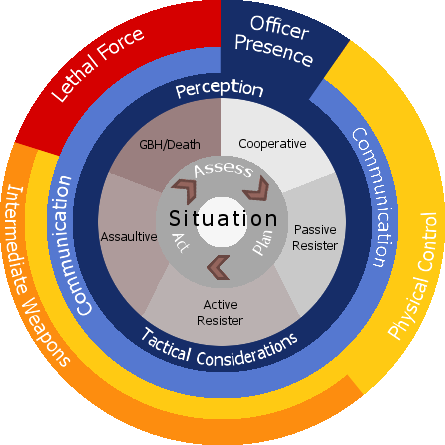Guide to Use of Force
The intent of this guide is to provide basic, realistic use of force guidelines to allow security players to avoid getting in trouble with admins and/or becoming shitcurity, and to provide security players with resources through which to better roleplay as a law enforcement professional.
Introduction
In a use of force situation, it is the subject that determines the level of force used, not the officer. Law enforcement use of force is reactive. Different threat levels place the subject in different "subject behavior categories", and different categories allow different "officer response options" to be legally acceptable.
Continuous Risk Assessment is a key principle in use of force. Subjects can and will change behavior categories in the course of an encounter. For example, a suspect with a laser gun falls under the GBH/Death subject category, allowing an officer to use all potential use of force options. However, if the officer uses a taser to stun the suspect, the subject behavior category is reduced while the suspect is stunned, and lethal force would be unacceptable during this period.
Remember that just because a certain level of force is permissible in a situation does not mean one should automatically use the maximum allowable force. The best strategy limits the likelihood of loss of life, injury, or property damage.
Subject Behavior Categories
Cooperative
Subject responds to verbal directions and commands, offers no resistance.
Passive Resister
Subject does not comply with lawful requests or directions and may offer verbal resistance, but offers no physical resistance and does not attempt to interfere with officer's attempts to control. Unlikely to be encountered in SS13.
Active Resister
Subject actively resists efforts to control by running away, physically pulling away from the officer, grabbing fixed object, etc.
Assaultive
Subject physically assaults, or attempts to assault, officer or citizen, through punches, kicks, etc. Verbal or implied threats prior to active assault can place a subject in this category.
Grievous Bodily Harm (GBH) or Death
Any actions by the subject that are likely to cause greivous bodily harm or death to an officer or citizen. Multiple assailant confrontations and weapons place a subject in this category.
Officer Response Options
Officer Presence
Visual image of uniformed officer, present at all subject categories.
Communication
Present at every subject category, although understandably difficult during SS13 combat. Attempt to deescalate situations through verbals.
Physical Control
Handcuffing, dragging, hand-to-hand combat. Acceptable to different degrees at all subject categories.
Intermediate Weapons
Pepper spray, stun batons, flashers, tasers, flashbangs, teargas, energy guns set to "stun," etc. Acceptable at the active resister category and higher.
Lethal Force
Laser guns, energy guns set to "kill," projectile firearms, lethal grenades, etc. Only acceptable at the GBH/Death category.
The Objective Reasonable Test
- Was the officer lawfully placed?
- Did the officer subjectively believe the amount of force used was reasonable?
- Would a reasonable person believe the level of force used was reasonable?
The answer to all three questions should be "yes."
AIM - Ability, Intent and Means
When placing a subject in a behavior category, evaluate the following:
Ability
Is the subject able bodied? Is their ability impeded (moving slowly due to hunger/injury, drunk, seizuring, etc)?
Intent
Displayed both verbally and physically.
Means
Does the subject have the means/mechanism to carry out the behavior (e.g. is there a door/wall/window blocking them from harming you)?
Conclusion
- Consider the totality of circumstances.
- No two situations will ever be the same.
